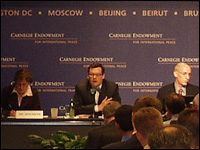Registration
You will receive an email confirming your registration.
IMGXYZ809IMGZYX Gregory Kulacki and Jeffrey Lewis argued in a joint presentation that the common arguments about China’s anti-satellite test—that the test was a shot across the bow of American space superiority or an attempt to force the U.S. into negotiations to restrict the development of space weaponry—are based on limited information and unreliable sources. Further, such explanations view China as a unified, rational decision maker, rather than a complicated bureaucracy in which conflicting interests compete for attention and resources, and mistakes can be made. Commentators and officials should be cautious in assessing Chinese intentions with limited information, Kulacki and Lewis advised at the Carnegie Endowment on November 13, 2007.
Kulacki specializes in intercultural education and exchange, and lived and worked in China for 12 years. He currently works for the Union of Concerned Scientists, and helps facilitate dialog between the American and Chinese military-space industries. Kulacki said that his Chinese colleagues’ explanation of the development and testing of the ASAT test was wildly divergent from American interpretations, but that most American assessments of the test haven’t considered the accounts of people intimately involved in the development of the weapons system.
Jeffrey Lewis, Director of the New America Foundation's Nuclear Strategy Initiative, noted that the Chinese version of the ASAT test story has mainly been a technocratic one, involving the failure of the bureaucracy to effectively predict the response of the international community to the ASAT test. The test is therefore viewed in certain communities in China as a policy failure.
China’s technical community has been following U.S. and USSR space tests since 1971, Lewis and Kulacki said. In contrast with claims that Chinese interest in ASAT technology is a new response to a perceived American threat, Kulacki and Lewis noted the long-standing Chinese interest in a general military-space capability. The development of ASAT technology began in earnest in the early ‘80s. It was underfunded until the bombing of the Chinese embassy in Belgrade, when China’s defense expenditures were increased across the board. Lewis argued that the timing of the test was a result of when the technology had matured.
Lewis and Kulacki addressed the issue of the debris resulting from the demolition of the satellite. Some Western observers have speculated that Chinese estimates of the amount of debris created by the ASAT were substantially low, but Lewis and Kulacki showed that both government and independent estimates were fairly accurate. Lewis and Kulacki said it was likely that Chinese officials were advised not on the relative increase in the amount of debris created, but instead on the absolute increase in the risk of damage to another satellite, which is about 1%. To an engineer, that number doesn’t seem all that high, and, Lewis noted, engineers were the people driving the development of the ASAT.
Lewis then turned to the two dominant narratives of China’s ASAT test that have been popularized in the US. The first is that the ASAT test was part of an effort to optimize Chinese defense capabilities vis-à-vis the U.S. by “hitting the US where it hurts,” he said. But Lewis and Kulacki said that the people they’ve talked to have not discussed the test in those terms. Kulacki noted that the so-called “soft ribs” arguments rely on many of the same low-quality sources, published by graduate students in fringe journals. Others have speculated that the ASAT test was intended to force the U.S. into negotiations over the military use of space. Both of these explanations rely on the premise that China had accurately predicted the response of the US to the tests. The unpreparedness of Chinese officials in the aftermath of the ASAT test is not inconsistent with the statements of technocrats, who framed the development of the ASAT as part of a general drive to improve China’s military capabilities in space, not as an effort to provoke the U.S.
In other words, many Chinese feel the test was a mistake, and was bad for Chinese security, and that there are problems with the Chinese decision-making process. People in the general armaments department pursue military technologies for different reasons than policy makers; often, the goals of these groups may be rival.
During the question and answer session, Lewis and Kulacki said that they did not know whether or not China’s ASAT test was aimed at the U.S. and that assessing China’s intentions is in fact impossible given available information. They encouraged greater dialog between China and the US to help avoid dangerous accidents and misunderstandings.
One member of the audience expressed concern that China remains bad at judging the reaction of the international community. The missile tests in 1996 were another instance where Chinese officials appeared shocked at the outrage they had fomented. Kulacki agreed, but added that the problem is of cross-cultural communication, heading in both directions—not only is China bad at predicting how things will look to the U.S., the U.S. is bad understanding Chinese motivations. Currently, China is the only space faring nation excluded from international space agreements; Chinese scientists are banned from attending aerospace conferences in the U.S.; U.S. space experts were expressly forbidden from talking to their Chinese counterparts. Such measures increase suspicion and misunderstanding, Kulacki said, and the U.S. would be better off without them.
